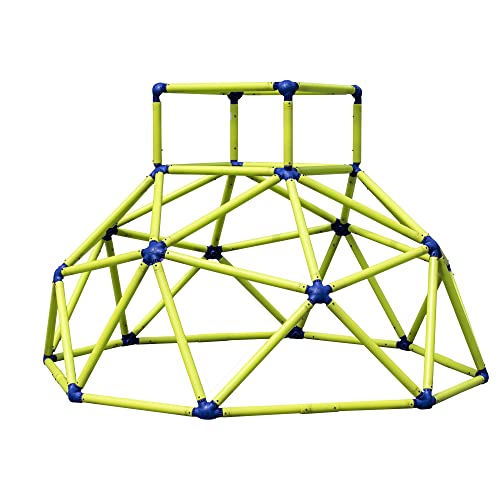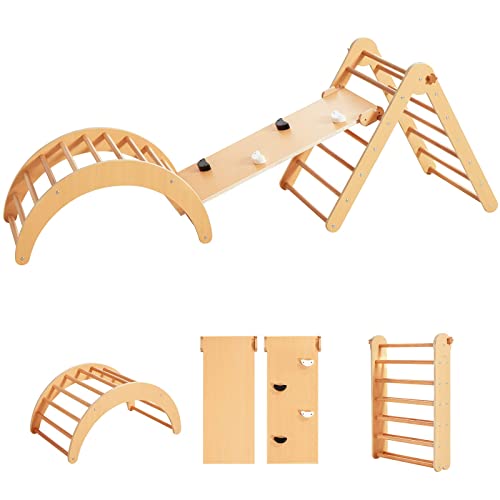Climbing scaffolds inspire every age. Even the strictest adult becomes a child again when climbing. And even the very little ones already have their fun with it!
But what should you look for if you want to offer your child a safe and fun experience?
We have created a guide with the most important criteria for you in this large offer and also directly present product recommendations. There is surely something for you!
Table of contents
The Bestsellers Of Children’s Climbing Frames
In a list of bestsellers, we have compiled the most popular climbing frames for children for you.
Checklist For Climbing Frames For Kids
- Use of a climbing frame should not occur before 3 years of age.
- Up to an approximate age of 7 to 8 years, children should not play on the climbing frame unsupervised. This also depends on the individual developmental stage, among other things.
- You can also look for quality seals such as the GS or a TÜV seal, which guarantee a high level of safety for the equipment.
- If in doubt, you should choose a scaffold made of impregnated wood. This is more stable than plastic.
- Make sure that all screws of the climbing scaffold are covered with screw covers to prevent injuries.
- You should also make sure that there are enough possibilities for your child to hold on. Choose a scaffold with one too many handholds rather than one too few.
- The size of a climbing frame is extremely variable and should depend on how much space you have available and how many children should be able to play on it at the same time.
- From about 2 meters in length you will find suitable products.
- For more than one child, it is better to choose a scaffold from a length of 3 meters upwards.
- Before buying, check that detailed assembly instructions are included. This is the only way to ensure safe play.
- If necessary, the seller may even offer an assembly service. If you want to be sure, check this and take advantage of it!
- Climbing scaffolds can also be assigned to different theme worlds Pirate ship, Viking ship, castles, spaceships, etc.
- You can take your child’s interests and preferences into account when choosing.
- Many climbing frames can be combined with other components
Swings, slides, sandboxes, etc. - If you plan to expand the structure at a later date, you can check directly whether a product offers direct expansion options.
- For additional protection, you should also purchase fall protection mats, which are laid out underneath the climbing scaffold.
- If necessary, elements of the scaffolding can also be exchanged to offer more variety. If that’s important to you, then feel free to check beforehand whether there are variable elements here. Often swings can be replaced by climbing ropes, climbing walls by ladders or slides by slide bars.
- While most climbing frames are intended for outdoor use, there are also certain constructions for indoor use.
- These are also suitable for even younger children from about 1.5 years.
- They are made of lightweight plastic and are usually barely more than 1 m tall.
- Again, they should not be played with unsupervised to ensure the greatest possible safety.
Recommended Climbing Frames For Children
Using our checklist for children’s climbing frames, we have made a recommended selection of children’s climbing frames that meet the criteria.
Outdoor Climbing Frames
Your own climbing frame in the garden. This is the dream of many children. With these children’s climbing frames, they can experience exciting climbing adventures in their own backyard.
Indoor Climbing Frame
It’s raining outside and the weather doesn’t invite you to climb outdoors at all? No problem! With these children’s indoor climbing frames, little adventures can climb in any weather.
Keine Produkte gefunden.
Tip: You can find many more great indoor climbing frames for kids in our guide to indoor climbing frames.
Current Offers Of Climbing Frames For Children
You can find the best current offers on climbing frames for kids in this list.
FAQ About Climbing Frames
Children make their first climbing experiences at the age of 1.5 years. However, proper climbing frames should not be considered before the age of 3
Smaller climbing devices, such as climbing triangles, can be used as early as 1.5 to 2 years of age. However, proper outdoor climbing frames should not be purchased until the child is 3 years old
Mainly the motor skills of the child are challenged and promoted. In addition, a certain logical understanding. The child has to find its own way and then cover it to get over the climbing frame.
Indoor scaffolds usually turn out to be much smaller and are made of softer plastic for space and safety reasons. They are intended more for the very young. For example, a climbing triangle is recommended here
This question can hardly be answered in a general way. It always depends on how many children with what interests and preferences at what age want to play on it. In general, however, it can be said that scaffolds made of solid and impregnated wood are sometimes the safest
While a good 90 cm high climbing triangle should be considered for very young children at around 2 years of age, all other heights tend to depend on the child’s individual stage of development. Either way, climbing should not be done unsupervised until about 7 to 8 years of age.
More On The Topic
Garden fun
- The 5 best playground equipment from Gartenpirat – guidebook
- The 105 best garden toys – guide
- The 8 best badminton rackets for children – guidebook
- The 8 best basketball hoops for home – guidebook
- The 9 best sandboxes for children
- The 7 best paddling pools for children – Guidebook
- The 14 best garden lights – guidebook
- The 8 best badminton rackets for beginners & advanced players – guidebook
- The 8 best unicycles for children – guidebook
Climbing frames for children
- Recommended climbing triangles for children
- Recommended indoor climbing frames for kids
- The 15 best indoor climbing frames for kids
- The 5 best Pikler triangles for children
- The 9 best climbing triangles for children
- The 17 best climbing frames for children
- The 10 best play towers with slide
Outdoor fun
- The best children’s bicycles – guide
- The 5 best scooters from Puky – guidebook
- The 15 best tricycles for children – guidebook
- The 10 best skateboards for kids – guidebook
- The 9 best inline skates for kids – guidebook
- The 10 best waveboards for kids – guidebook
- The 10 best roller skates for kids – guidebook
- The 10 best penny boards – guidebook





















